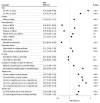Sociodemographic Characteristics Associated With and Prevalence and Frequency of Cannabis Use Among Adults in the US
- PMID: 34846523
- PMCID: PMC8634054
- DOI: 10.1001/jamanetworkopen.2021.36571
Sociodemographic Characteristics Associated With and Prevalence and Frequency of Cannabis Use Among Adults in the US
Abstract
Importance: Cannabis use has increased, but there are few studies on frequent and daily cannabis use among US adults. Individuals who engage in higher frequency use may suffer more health consequences.
Objective: To examine frequency of cannabis use and associated factors among US adults.
Design, setting, and participants: This survey study included data from 21 US states and 2 US territories reported in the Behavioral Risk Factor Surveillance System surveys from 2016 to 2019. Cross-sectional data on US adults ages 18 years and older were used to estimate demographic, socioeconomic, and behavioral risk factors for cannabis use, taking into account the survey strata and sampling weights for the 4 years of combined data. Using a multivariable ordinal logistic analysis, the association of demographic, socioeconomic status, and behavioral risk factors with past month cannabis frequency were examined.
Exposures: Sociodemographic characteristic, ie, age, gender, race and ethnicity, educational attainment, employment status, and annual household income.
Main outcomes and measures: Ordinal categorization of number of days of cannabis use in the past 30 days in terms of nonuse, infrequent use (1-5 days), frequent use (6-29 days), and daily use.
Results: Among the 387 179 respondents, 58 009 (27.9%) were ages 18 to 34 years, 186 923 (50.3%) were ages 35 to 64 years, and 142 225 (21.8%) were age 65 years or older (mean [SD] age, 48.3 [0.1] years). The sample included 28 345 (9.8%) Black, 36 697 (22.6%) Hispanic, and 292 210 (57.3%) White respondents. Smoking was the most common form of cannabis use. The frequency of cannabis use varied significantly by age, gender, race, marital status, education, and employment. Higher frequency cannabis use was associated with younger age (ages 18-34 years: adjusted odds ratio [aOR],4.12; 95% CI, 3.63-4.68; ages 35-64 years: aOR,2.22; 95% CI, 1.98-2.49), Black (aOR, 1.46; 95% CI, 1.33-1.71) and Native American (aOR, 1.25; 95% CI, 1.04-1.52) race, and less educational attainment (high school or less: aOR,1.09; 95% CI, 1.02-1.17; some college: aOR,1.27; 95% CI, 1.19-1.35). Being married (aOR, 0.54; 95% CI, 0.51-0.58) or identifying as Asian (aOR, 0.60; 95% CI, 0.51-0.71) or Hispanic (aOR, 0.71; 95% CI, 0.65-0.77) was associated with lower-frequency cannabis use after accounting for other baseline factors.
Conclusions and relevance: This nationally based study found that higher-frequency cannabis use is more common among young and racial minority populations, as well as respondents with low socioeconomic status. Given the known and emerging negative health effects of cannabis use, more attention may need to be paid to high-frequency use among underserved populations in the form of screening, risk stratification, and treatment.
Conflict of interest statement
Figures
References
-
- Center for Behavioral Health Statistics and Quality . 2019 National Survey on Drug Use and Health: Detailed Tables. Substance Abuse and Mental Health Services Administration . September 11, 2020. Accessed October 27, 2021. https://www.samhsa.gov/data/report/2019-nsduh-detailed-tables
-
- Morris MA, Jacobson SR, Kinney GL, et al. . Marijuana use associations with pulmonary symptoms and function in tobacco smokers enrolled in the subpopulations and intermediate outcome measures in COPD study (SPIROMICS). Chronic Obstr Pulm Dis. 2018;5(1):46-56. doi:10.15326/jcopdf.5.1.2017.0141 - DOI - PMC - PubMed
Publication types
MeSH terms
Grants and funding
LinkOut - more resources
Full Text Sources
Miscellaneous


